Ultius Blog
Is Zika a Threat to the United States [Infographic]?
Zika—what's the big deal? This research-intensive article outlines why Zika is not a major threat to the United States. Relevant data from the Center for Disease Control, World Health Organization, and other health agencies highlight how the disease is a minimal risk to American citizens. You can skip to the infographic that summarizes everything, or read the entire post.
In the news over the past several months, you have probably heard of a strange new virus spreading across America: Zika. Writing for the academic journal Microbes and Infection, Camilia Zanluca and Claudia dos Santos have indicated that Zika is an important new virus that has emerged in the world today and that it has the potential to produce epidemics if populations are not properly prepared to resist this threat.
This article will analyze the potential threat Zika poses and whether or not claims of its danger are overstated.
Background information on the Zika Virus
There are, of course, many different infectious diseases in the world, and it may be difficult for the average person to keep up to speed with these different diseases, much less recognize the actual threat presented by any given disease. If you are like most people, for example, you may perhaps mix up Zika with Ebola. Both have uncommon, somewhat similar names, but are actually quite different.
Comparison to the Black Death
And, of course, when you hear about any epidemic in the world, your mind probably cuts to the classic example of how bad things could possibly get. You may think, for example, of the bubonic plague in medieval Europe, also known as the Black Death. According to Ole J. Benedictow of History Today, the Black Death of the 14th century, spread primarily by rats, killed 50 million out of 83 million Europeans—in other words, 60 percent of the total population.
| Europeans Impacted by Plague | Number |
| Killed by plague | 50 million |
| Survived plague | 33 million |
| Total Europeans | 83 million |
More recently, Americans may recall learning about the flu pandemic of 1918. The United States Department of Health and Human Services estimates between 30-50 million people were killed world-wide, including approximately 675,000 Americans.
With this context, a little fear is only natural when you hear about the possibility of a new epidemic of any kind. The reaction over the 2014 Ebola outbreak, as written about by Ultius, was generally one of fear. It is important to ask the critical question, though, of whether your fear is rationally justified or if it is just an immediate emotional response without a basis in objective fact.
Zika: A case of misinformation, fear and paranoia
If you run a search for Zika on Google, you can find anything on the subject—and we mean literally almost anything. You can find everything from information saying that Zika is actually a governmental hoax to claims that Zika is the precursor of the fulfillment of the biblical Book of Revelation.

In this context, it can be very difficult for the average person to filter all the information out there in order to get some sense of the actual truths about the Zika virus. The truth is surely somewhere in between, of course. But clearly, the Zika virus cannot be both a hoax and an apocalyptic threat at the same time. The odds are that it is neither of those two things.
Given this state of affairs, the credible and truthful information in this article will get you up to date about the status of the Zika virus at the present time (October 2016). This article will draw from credible sources and objective research in order to develop a comprehensive sense of what is and is not true about the Zika outbreak thus far.
In order to do this, the article will begin with an overview of the backstory of Zika. Ultius has highlighted in a previous blog, how, along with struggling economy, Zika cast a negative light on the recent Olympic Games in Brazil. It will also evaluate five key myths regarding Zika and their validity.
The five key myths regarding Zika
1. Zika is rampant within the United States at the present time.
2. The threat posed by Zika has been overstated by the media.
3. Zika has the potential to become as serious a pandemic as the great and terrible plagues of the past.
4. Zika is deadly for the average adult of normal health.
5. Zika can be transmitted through sexual interaction.
The article will conclude with a reflection on what you should or should not do in order to participate in the fight against Zika.
Medical information on the Zika Virus
Zika is considered a flavivirus. A flavivirus is a virus that is transmitted by mosquitoes, and is in the same classification of virus that includes other illnesses such as West Nile, Yellow Fever, and Malaria. The name Zika originates from the place where the virus was first discovered. According to the World Health Organization, in 1947, the first trace of the virus was discovered within a captive rhesus monkey from a forest region in Uganda known as the Zika forest, near Lake Victoria.
In other words, Zika is not exactly a new virus. What is new, however, is its presence in the United States.
Over the years after Zika was first discovered in Africa, its reach may have extended across Asia. Mary Kay Kindhauser et al., though, writing for the World Health Organization, indicated that 2007 was something of a turning point in the story of Zika:
"Zika spreads from Africa and Asia to cause the first large outbreak in humans on the Pacific Island of Yap, in the Federated States of Micronesia. Prior to the event, no outbreaks and only 14 cases of human Zika virus disease had been documented worldwide."
From this point, the Zika virus continued to proliferate across the Pacific Islands. In the year 2015, the virus was found in Brazil. This would be the first case of Zika within the Americas. The virus then continued to migrate north through Central America and has now invaded the United States.
It is unknown whether Zika will continue to travel north or how far north it could reach in the future. Eerily, this may sound all too familiar to Americans. After all, it was only in 1999 that the mosquito-borne West Nile Virus was introduced to America and, at the the time of this writing (October 2016) cases have been reported in 46 out of 50 states according to the CDC.
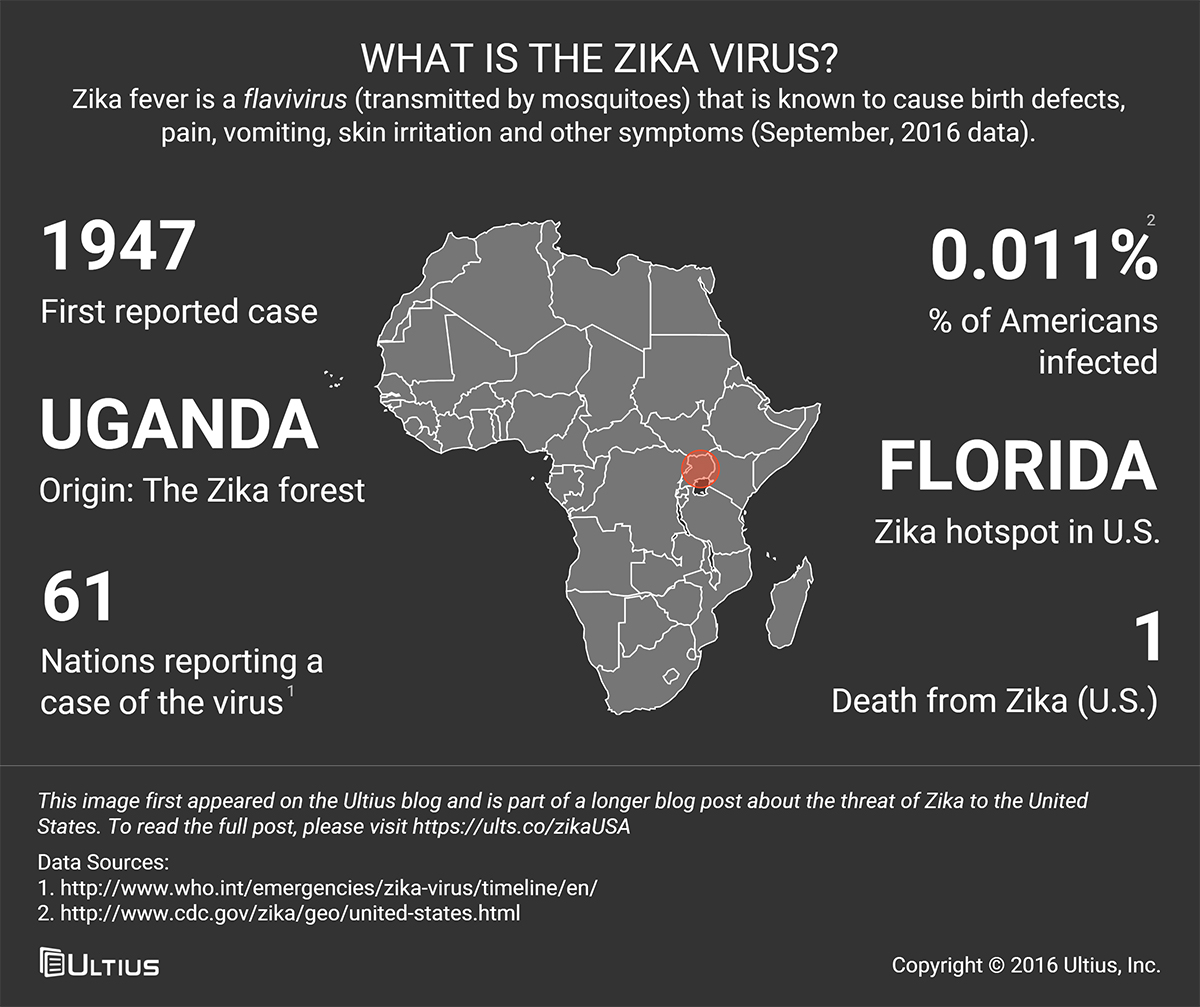
Symptoms of Zika
It’s important to recognize that if you contract the Zika fever, you are most likely to experience mild symptoms that can last upwards of one week. In many cases, patients don’t even visit a hospital because the symptoms resemble other viruses or ailments. In other cases, there are no physical symptoms whatsoever. Here are the core symptoms you can expect if you contract Zika.
Zika Fever: Symptoms
- Fever (and the chills)
- Skin rash
- Joint pain
- Red eyes and general discomfort
- Headache
- Muscle pain
- Vomiting
- Sweating
- Loss of appetite
- Fatigue
According to the CDC, you probably won’t die from Zika and treatment options are the standard regimen for most ailments: rest, hydration, anti-inflammatory drugs, and acetaminophen. As of October 2016, there is no cure or vaccine. However, Zika has been known to cause some serious birth defects by way of fetal transmission from mother to child. This condition (mentioned later in this article) has prompted the U.S. Department of State to issue travel warnings for some countries. Therefore, pregnant women experience a far greater risk of future problems than people who aren’t carrying children.
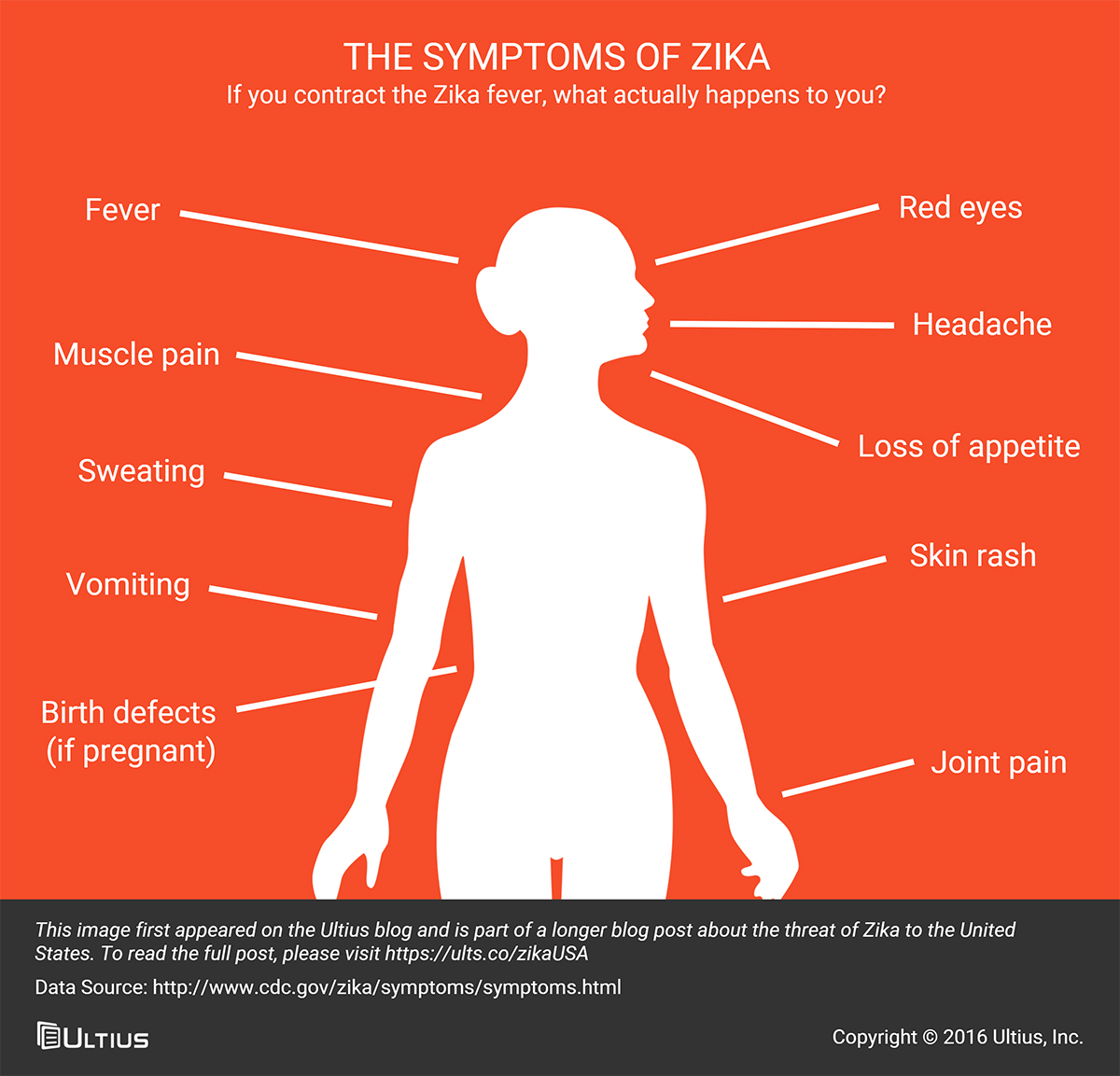
The case of Brazil (and abroad)
The appearance of Zika in Brazil coincided with the nation's preparations to host the Olympic Games. Naturally, this caused serious questions to be raised about whether it would be safe for athletes and fans to travel to Brazil in order to either participate in or be spectators to the games.
Interestingly, Daniel Epstein et al., in a news release for the World Health Organization, indicated that there was no justifiable reason for canceling, postponing, or changing the location of the games. He noted that, not only is Zika not a serious enough threat to warrant such a course of action, but also that people were already traveling to and from nations known to have Zika without any restrictions anyway.
The real global distribution of Zika
The press release says that "almost 60" nations in the world have Zika. A more recent and precise count, according to the World Health Organization again, would seem to put the number at 61, though the number may be more by the time of the writing of this article.
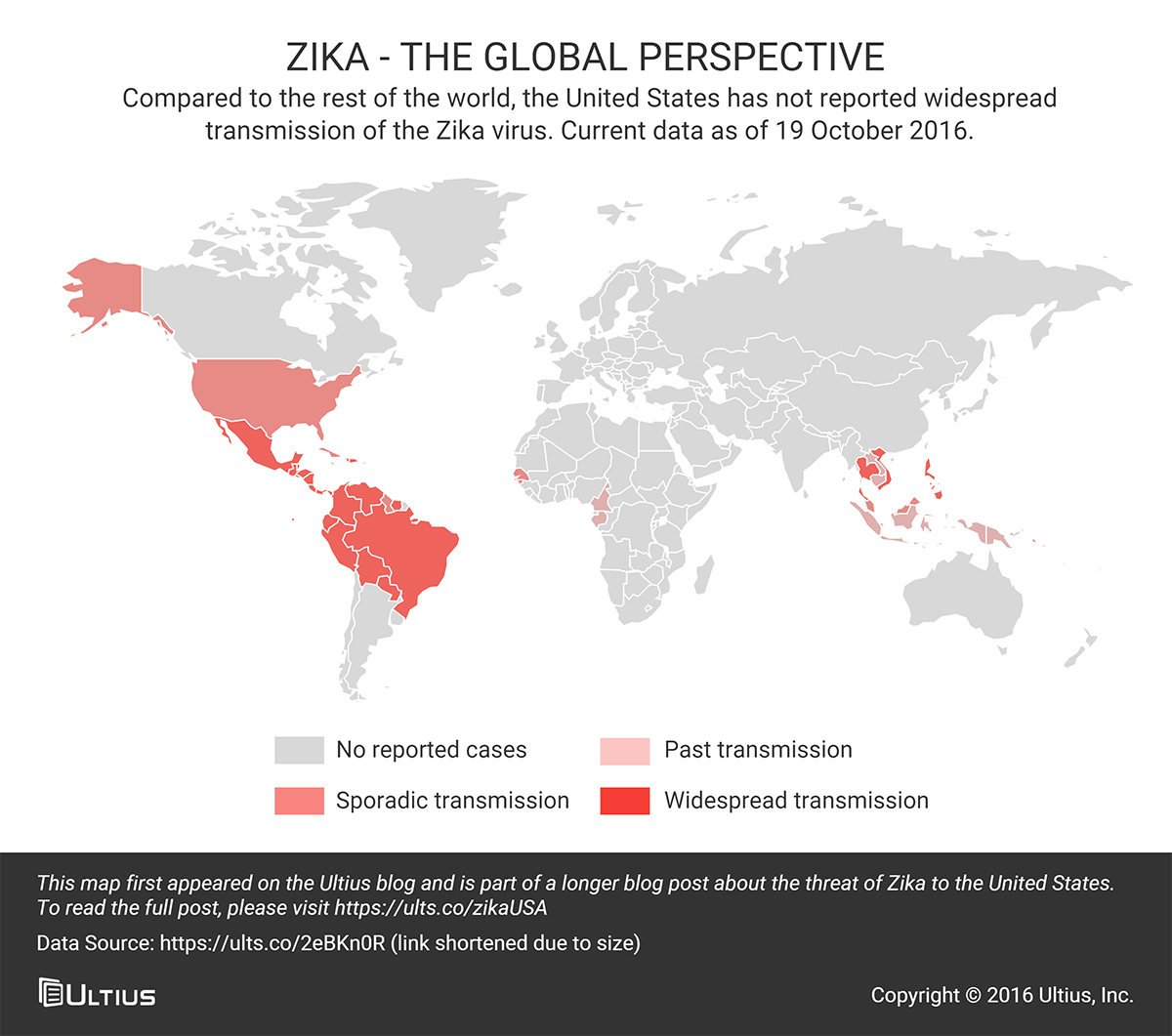
Moreover, it is difficult to calculate the percentage of specifically American (North, Central, and South) nations that have Zika due to the fact that different sources tend to define "America" itself in different ways. But virtually all sources agree on the fact that most American nations, including islands such as Cuba, where the American embargo was recently lifted, by now have has some contact with Zika.
In this context, it makes sense that the Zika scare did not really have a serious effect on the summer Olympic Games in Brazil. If the threat were really all that serious, major global restrictions on travel should have already been in place, especially if you consider the fact that Zika can now be found in almost a third of all the nations of the world. The fact that such restrictions have not been implemented suggests that the Zika threat is largely under control or, at the very least, that it is not serious enough to interfere with the normal travel and event plans of most of the people of the world.
This brings us to the situation of the Zika virus within the United States at the present time which, in turn, brings us to the first myth about Zika that will be considered in the present article.

Myth #1: Zika Is rampant within the United States [False]
A key myth about the Zika virus is that Zika is, in fact, rampant within the United States at the present time. This myth is false. In order to get a meaningful sense of the scope and scale of the Zika threat within the United States, it is necessary to turn to the hard epidemiological evidence on this subject rather than whatever news reports one happens to watch or hear.
Among other things, it is very difficult to get a sense of scale or proportion from news reports taken out of context. Only the actual research evidence can give us a real sense of how the situation actually stands at the present time.
This is what the Centers for Disease Control and Prevention, hereafter called the CDC, has to say about Zika within the United States, current as of the 28th of September, 2016: there have thus far been a total of 59 cases locally acquired from mosquitoes, 3,565 cases acquired from travel, and 1 single case acquired from a laboratory, for a grand total of 3,625 cases.
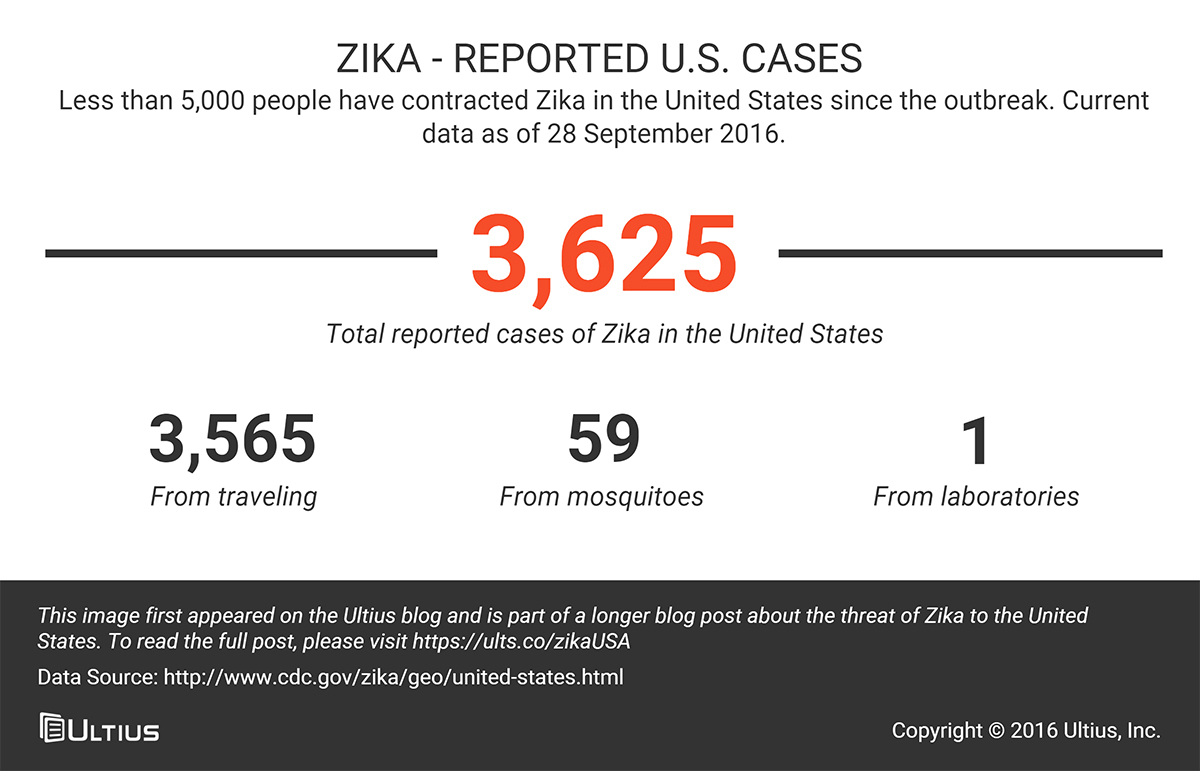
In other words, almost all of the cases of Zika within the United States (as of September 28, 2016) can be traced back to either travel to an infected nation or contact with a person who has recently engaged in such travel, as opposed to those who contracted the virus locally.
The case of Florida
It is worth pointing out that, according to the CDC's epidemiological data, all 59 mosquito-borne cases within the United States have occurred within a small area of Florida near the city of Miami. So far, this is the only tiny part of a large nation in which mosquitoes actually carrying Zika have been found. This is in line with the broader trend of Zika being much more prevalent within the islands territories or tropical areas of the United States than on the middle of the continent itself. Also worth consideration is the fact that Florida is roughly 90 miles away from Cuba where Zika-carrying mosquitoes are also prevalent.
Comparison with Brazil
By way of meaningful contrast, it is worth pointing out that Natália Cancian, writing on behalf of the Government of Brazil itself, reported back in April 2016 that there were 91,387 probable Zika infections recorded within Brazil.
| Country | Zika Cases (#) | % of Population Infected |
| Brazil | 91,387 | 0.456% |
| United States | 3,625 | 0.011% |
To suggest that Zika is "rampant" within the United States must be understood as a gross exaggeration: if one wants to know what rampant really means, one would need to conduct international comparisons, such as the one against Brazil you can see in the chart above.
3,625 is still a fairly large number; but then, this must be understood within the right context. For example, the number of Americans who get the common flu every year is most likely in the tens of millions. The common flu is so widespread that the CDC would seem to neither worry about or know how to actually count all the individual cases that occur. Every illness must be understood within its own context and, for Zika, 3,625 is in fact a quite small number that indicates that the United States' Zika containment efforts are meeting with success.
Myth #2: The Zika threat has been overstated by the media [Mostly true]
Some stakeholders have put forth the notion that the media within the United States has overstated the threat posed by Zika and that the problem is nowhere near as major as people imagine it to be. As Ultius previously wrote, it is well known that the media is biased toward sensational stories moreso than coldly factual ones. But in the most extreme variant, this perspective leads into the territory of conspiracy theories regarding Zika.
Here are some of the conspiracy theories regarding Zika that are populare in the blogosphere, summarized by Jack Crosbie of Inverse
- Zika was accidentally created by a British biotech company experimenting with mosquitoes.
- The CDC invented the Zika hoax and the whole thing is a scam.
- The Rockefeller family created Zika for reasons of their own.
- Chemical pollution is the real reason people are getting Zika.
- The agricultural corporation Monsanto is responsible for Zika.
Theories such as these are self-evidently absurd and aren't supported by any objective evidence. The fact is that Zika is a real virus with a real history, it is really transmitted by mosquitoes, and it is really infecting people across the world today. What can be questioned, however, is whether the media's coverage of Zika has been appropriate and proportional relative to the actual level of threat presented by the virus.
And the answer to this question would seem to be that the media's coverage of Zika has in fact been relatively sensationalistic and overblown. According to a poll conducted by Pew Research Center, only 14 percent of Americans have heard or read nothing about Zika while only 38 percent have heard or read enough to say they know a lot.
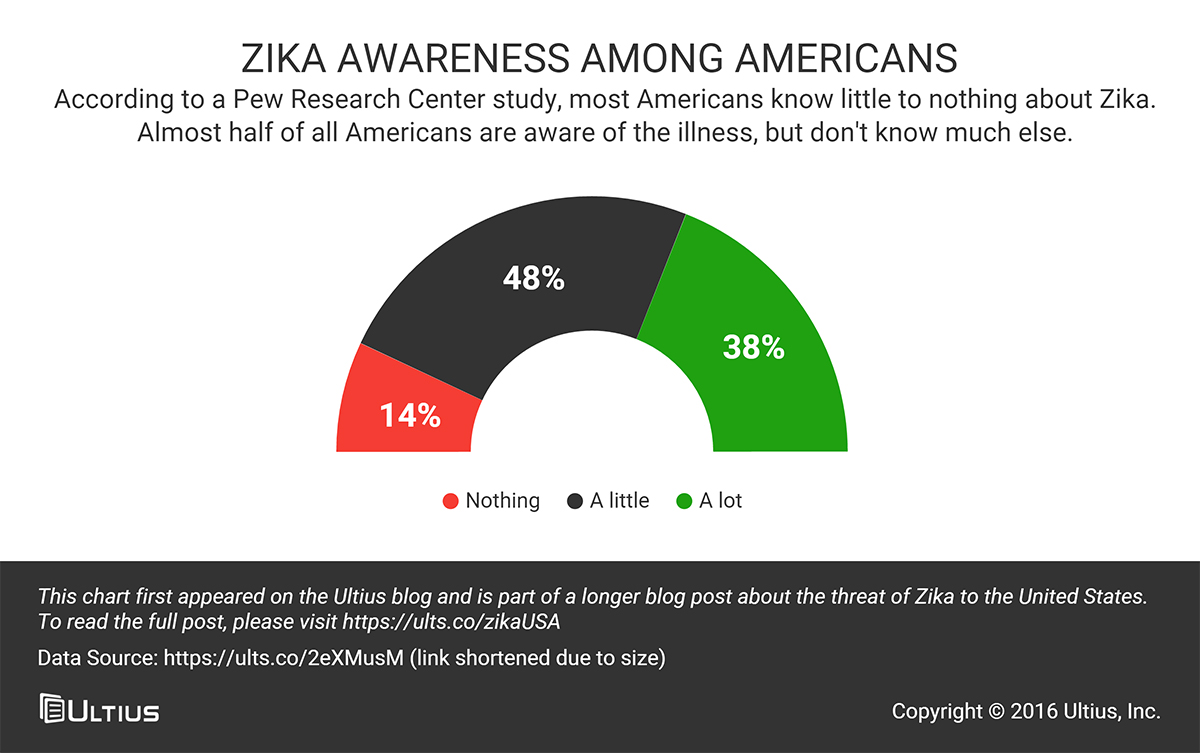
The media has clearly been successful in making Americans aware of Zika. But it is not clear whether this is because the media has simply talked far too much about Zika, relative to other important current issues.
For example, Insurance Institute for Highway Safety has indicated that 29,989 Americans died in fatal car crashes in the year 2014. Similarly, the Law Center to Prevent Gun Violence has indicated that the number of Americans who die from gun violence is in the tens of thousands every year, and was well over 32,000 in 2010.
Now, remember that there have been 3,625 cases of Zika infection in the United States thus far and, of these, exactly 1 person has died; and he was an elderly man with pre-existing health conditions.
Comparing the Zika fatality rates with other numbers highlighted above, you get something like this:
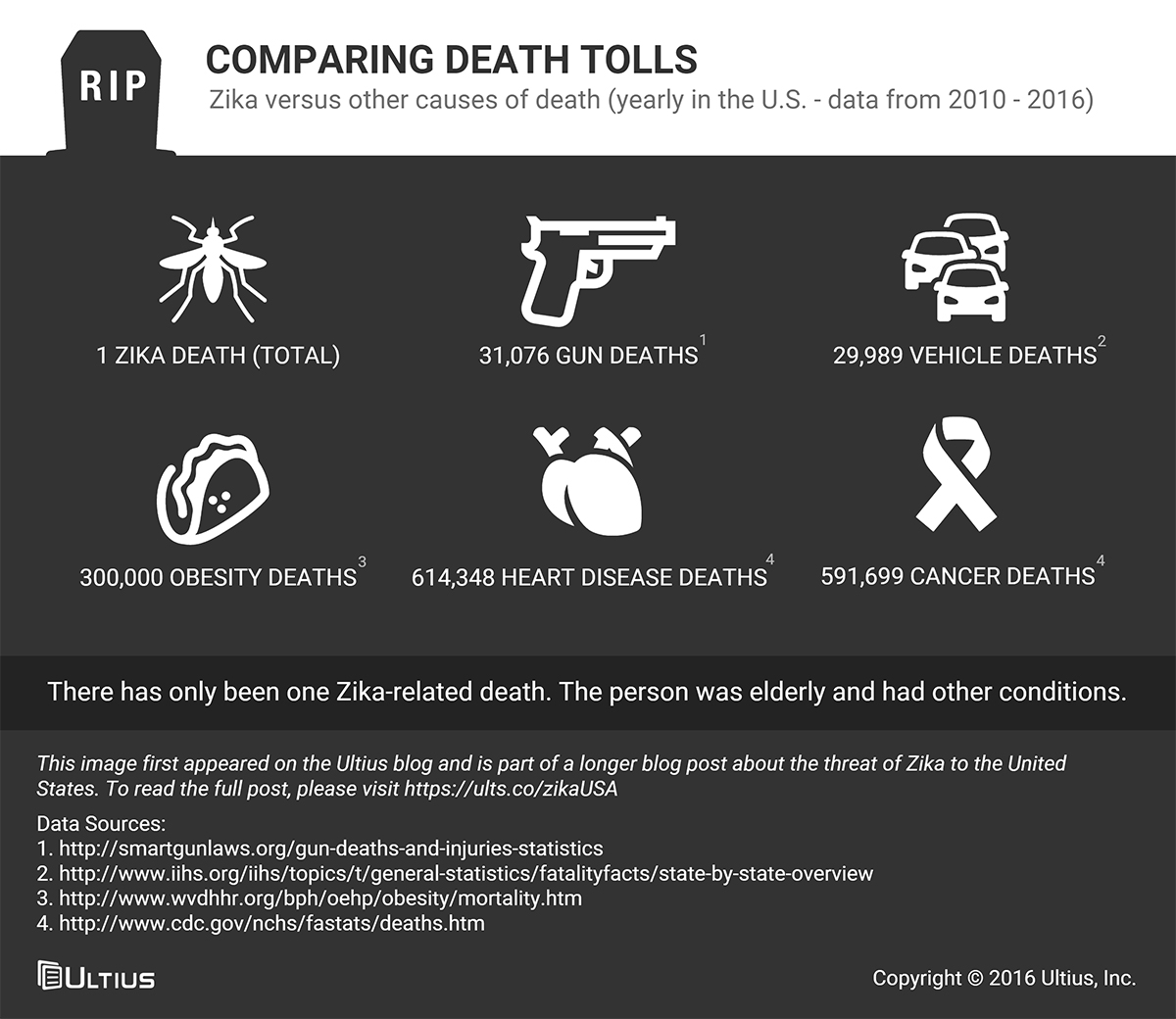
In this context, the argument can be made that Americans are paying proportionally too much attention to Zika and the media's coverage of Zika has been considerably overblown. The objective statistics clearly indicate that, as Americans, we surely have far bigger problems to worry about.
Myth #3: Zika has serious pandemic potential [Maybe]
One of the main concerns surrounding Zika is that it has the potential to turn into an unstoppable global pandemic. In general, the threat of pandemic has become especially acute within the current historical era of globalization which the Financial Times has defined as:
A process by which national and regional economies, societies, and cultures have become integrated through the global network of trade, communication, immigration and transportation.
This also makes the threat of pandemics far worse. Previously, groups of people were naturally segregated from each other by geographical boundaries. But now, a disease that emerges in one part of the world could potentially spread across the entire planet in a flash due to our ability to travel to nearly every part of the world in mere hours.
Zika has already spread across the world at a rapid pace. Although, for the most part, it seems that it has been contained to the tropics and the central part of the world in terms of latitude. These are the areas of the world where mosquitoes are most prevalent. As the global map above shows, for example, there are no reported Zika cases as of yet in nations that are further north on the planet.
When one hears the term "pandemic", however, one generally has some notion of catastrophic effects for the health of entire populations. And although Zika fits the literal definition of having pandemic potential, it is not clear that Zika also qualifies for this connotation of the word “pandemic”. For example, this is what Daniel Lucey and Lawrence Gostin have written of Zika in the Journal of the American Medical Association:
"Zika virus infection usually is asymptomatic or causes mild illness, such as fever, rash, muscle/joint pain, and conjunctivitis; severe disease and fatalities are uncommon" (865).
Even if Zika were to become a pandemic in terms of sheer numbers, it is not clear that the effects would really be as dire as a lot of people may imagine them to be. The fact of the matter is that the symptoms of Zika are often so mild that a lot of people who contract Zika may not even know that they even have the virus. Moreover, the illness generally tends to resolve itself on its own within a reasonable time frame.
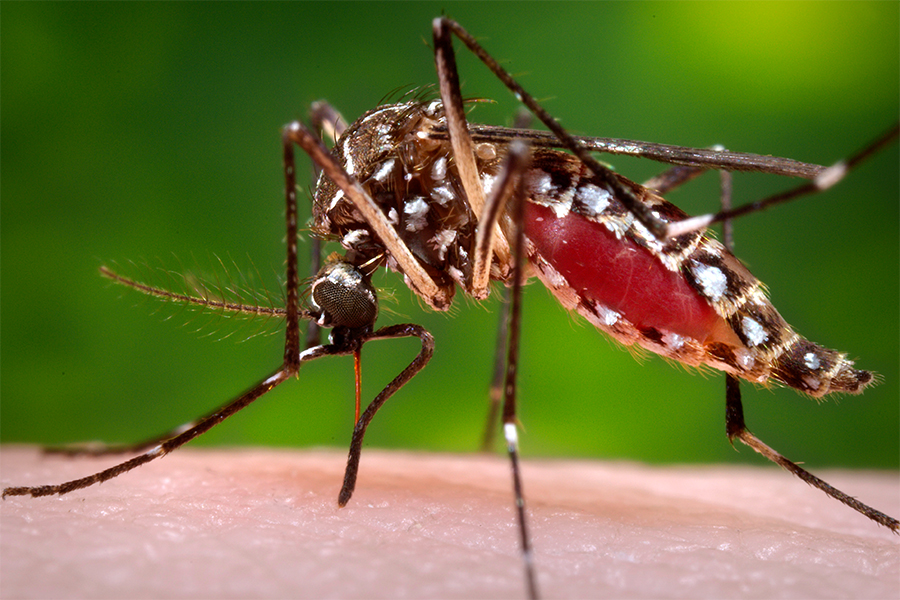
In short, whether Zika has pandemic potential depends on one's definition of a pandemic. Generally, the implication of a pandemic is that it is capable of killing a large number of people, very quickly. Understood in this sense, Zika has very little pandemic potential. On the other hand, it is in fact possible that in the absence of appropriate precautions, the number of Zika cases worldwide could multiply greatly over the coming years.
Myth #4: Zika is deadly for the average adult [False—with notable exceptions]
To expand on what has been said above, another myth about Zika is that it is in fact deadly for the average adult of normal health. This is clearly false based on the available objective epidemiological data. The average adult of normal health who contracts Zika will likely not even be aware they have Zika and the illness will almost certainly pass without causing serious harm to the patient.
Again, this relative lack of risk is made clear by the fact that neither the CDC nor the World Health Organization recommended that people avoid Brazil during the Olympic Games, even considering the high number of Zika cases were being reported in that nation.
Likewise, there have been no outright bans on travel to or from a nation where Zika is prevalent, unlike when travel restrictions were placed on west Africa during the Ebola outbreak of 2014. These would be basic protocols for public health agencies to take if the Zika threat really were as serious as some people have imagined it to be.
It’s not beyond rationality to think the danger of Zika is greater than it actually is reported to be. This may be due, again, to confusion with Ebola, which is a much more frightening and far deadlier disease and carries an extremely high fatality rate of around 50% according to the WHO. This may also be due, in part, to the stories of the Ebola outbreak still being fresh in our minds as the outbreak was only in 2014, a mere two years prior.
Caveat 1: Pregnant women who contract Zika can pass it to their unborn children, causing microcephaly
This generalized myth unfortunately draws attention away from a critical point regarding who actually is at risk of serious harm from Zika. In particular, there have been reports that if a pregnant woman contracts Zika, the child may be at risk of developing microcephaly. Microcephaly literally translates into "small head" and this graphic provided by the CDC illustrates exactly what happens to the developing fetus:
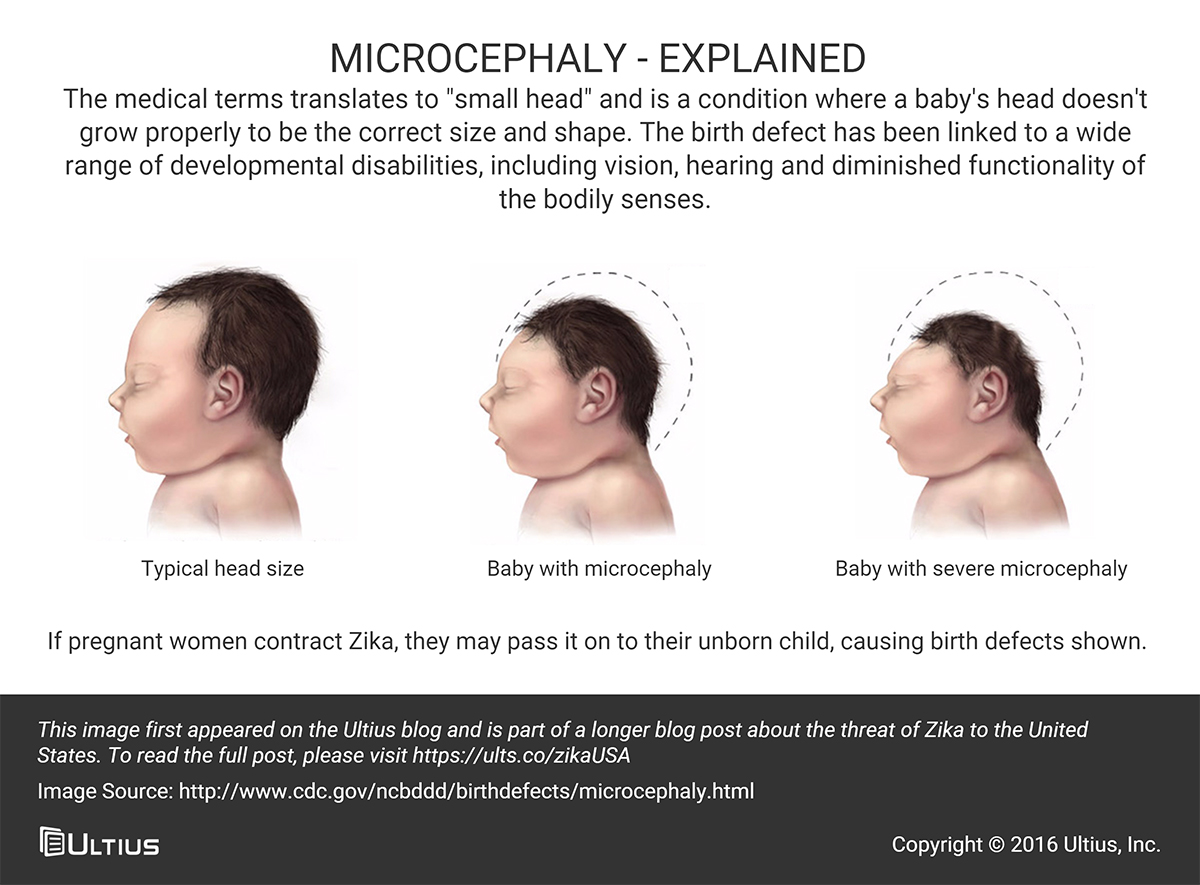
Microcephaly has been linked to a wide range of developmental disabilities, including intellectual disability and diminished functioning of the bodily senses including vision and hearing. Therefore, the recommendation can be made that pregnant women must be very careful about avoiding Zika infection.
Caveat 2: Correlation between Zika and Guillian-Barre Syndrome
Guillain-Barre Syndrome is a poorly understood disorder in which the patient's nervous system begins attacking itself. According to the CDC and other health agencies, some correlation has been found between higher prevalence of Zika infection on the one hand and higher rates of Guillain-Barre Syndrome on the other.
However, no clear epidemiological evidence exists on this matter at the present time and caution must be taken to not draw hasty conclusions. In particular, it is important to bear in mind that correlation often does not imply causation. In short, further evidence is needed in order to figure out what's really going on here and if there is, indeed, a direct correlation.
Caveat 3: Pre-existing conditions
It's probably a well-known fact that if a person has pre-existing conditions or is of elderly age then any illness at all may affect him/her more severely than it may affect others. Helen Branswell of Stat, for example, has suggested that the one man in the United States who has died from Zika infection, thus far, previously had a case of an illness called dengue. This may have made him more susceptible to develop severe complications from a Zika infection.
In short, Zika could possibly be very dangerous for a select few people, although this is clearly the exception more than the rule.
Myth #5: Zika is transmitted through sexual interaction [True]
Like the sexually transmitted diseases you learned about in health class, you may have also heard rumors that the Zika virus can be transmitted through sexual interaction. This article is here to tell you that this rumor is true. Zika is primarily transmitted through a mosquito biting an infected person and then biting another person, infecting them as well. The mosquito acts as a conduit between the infected blood and the clean blood. However, this calls attention to the fact that Zika can in indeed be transmitted through contact of bodily fluids which of course happens during sexual interaction.
A sense of proportion
Before you get too worried about this, though, it is worth considering some of the broader statistics regarding sexually transmitted diseases within the United States. The American Sexual Health Association (ASHA), for example, has estimated that as many as one in five Americans have genital herpes, but only 1 in 10 of those Americans may actually know that they have it.
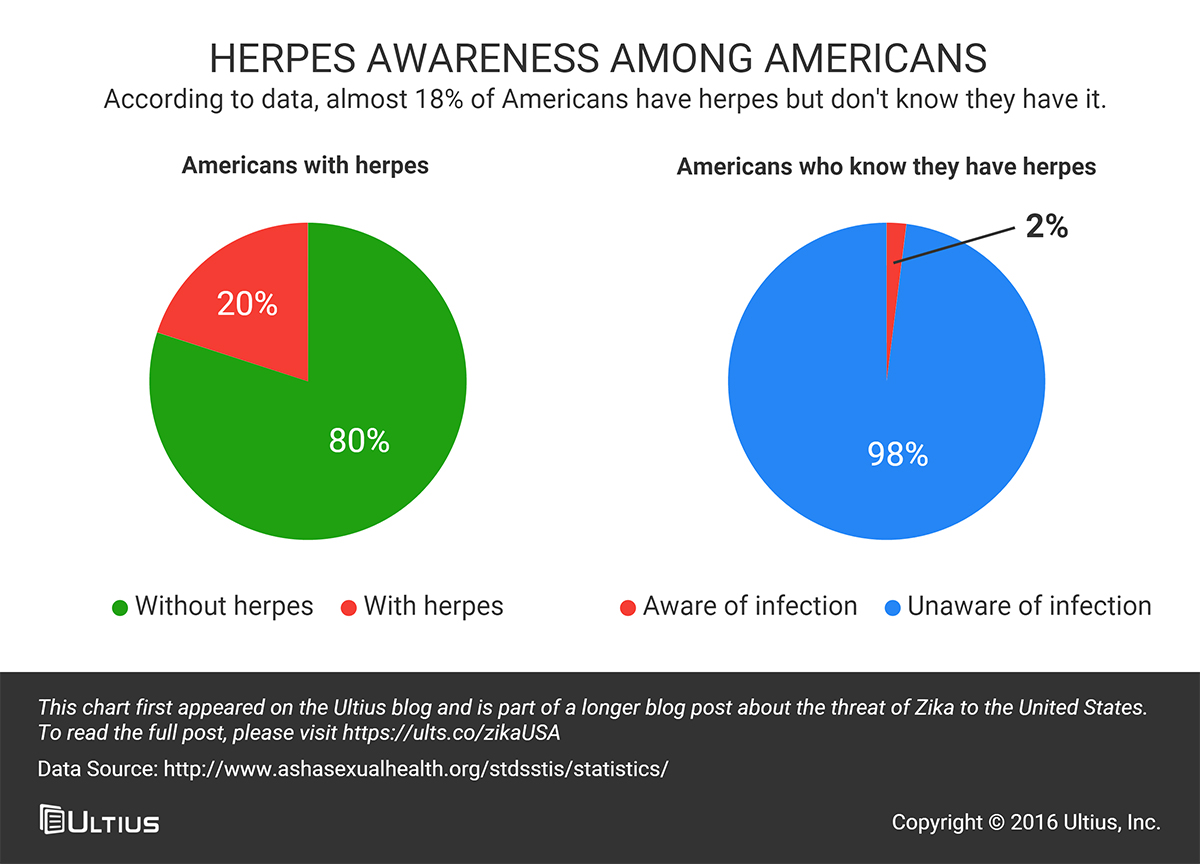
These statistics indicate that there are a full 18 percent of Americans who may have herpes but not actually know that they have herpes. This also means that they could pass it on to sexual partners with no warnings or moral qualms since, as far as they would be concerned, there would be nothing to warn their partners about.
A question that can be asked now is: if you are not worried about contracting herpes through sex, then why would you be about contracting Zika through sex? The cases of Zika within the United States thus far are so few as to be almost negligible, relative to the cases of herpes within the nation. And moreover, whereas herpes is a lifelong condition, Zika is a viral infection that tends to run its course quickly just like any other infection.
In short, then, there is once again a need for you to maintain a sense of proportion and scale regarding the Zika virus. In truth, the risk of catching Zika through sexual interaction, or at all, is so small that you probably should not even be worrying about it so long as you’re an average healthy adult.
So, what should you do?
Based on the discussion that has been conducted in this article, you may be wondering what you should specifically do in order to combat Zika. In the broadest terms, the answer is: pretty much nothing at all. The American government has done a fairly good job containing Zika. The actual level of threat posed by Zika has been completely overblown by the media, often at the expense of more important issues that deserve more coverage.
That said, there are three specific recommendations we can make for you about Zika on the basis of all the evidence that has been discussed in this article.
1. Be wary of the symptoms. If you are traveling to countries with a high prevalence of Zika or are in contact with people who have been to such countries, become aware of the symptoms of Zika. If you think you may have an infection, make sure you report this to your appropriate local health authorities.
2. Avoid traveling if pregnant. If you are a pregnant woman, please remain especially vigilant about traveling or being in contact with people who have recently traveled. This is because there is growing evidence that Zika infection could in fact harm fetal development in a serious way.
3. Pre-existing conditions. If you have pre-existing conditions or have a fragile health status for whatever reason, please also remain vigilant about potentially contracting the Zika virus. However, this recommendation is not specific to Zika per se: for a person of fragile health status, almost any illness, even the common cold, could potentially produce serious complications that it may not produce for others.
Other than that, there is little that can be done or said. The Zika threat, while real, is nowhere near as serious as you may have imagined it to be. Most Americans face far more serious threats to their health on an everyday basis, such as obesity, without a second thought.
Key takeaways
This article has consisted of a comprehensive overview and analysis of the threat presented to Americans by the Zika virus. The article began with an introduction and a definition of the problem and then proceeded to consider the backstory of the Zika virus, including its effect on the Olympic Games in Brazil.
Then, it proceeded to evaluate five key myths about Zika. These were: one, that Zika is rampant within the United States; two, that the media has overblown the level of threat presented by Zika; three, that Zika has serious pandemic potential; four, that Zika presents a serious threat to the life of an average healthy adult; and five, that Zika can be transmitted through sexual interaction.
On the basis of this analysis, a key conclusion that can be reached here is that the spread of the Zika virus is in fact a very real thing and that it is not some kind of fantasy that has been manufactured by whatever stakeholders for their own purposes.
On the other hand, however, it must also be said that the level of threat presented by the Zika virus has been significantly overblown by media outlets and general public discussion in the United States.
The Zika virus, while real, has had a very low infection rate within the United States thus far and virtually all of these infections have been the result of either travel or contact with travelers from regions where infection is more prevalent. Moreover, it should be noted again, that for most people, even if they contract Zika, the effects will often be much milder than the common flu, and they will get over the virus soon enough without any long-term health effects to speak of.
In short, then, the final conclusion that can be reached here is that the vast majority of Americans have far bigger things to worry about than Zika (like getting your Yahoo email account hacked). We shouldn't let the media distract us from the real problems we're facing in our private and public lives.
Medical information disclaimer: This post contains medical information related to herpes, Zika, and other illnesses. It's intended to be for informational purposes only and not medical advice. Please consult a medical professional before making any health-related decisions.
If you enjoyed this post, consider checking out some other great infographics we have available.
Works Cited
American Sexual Health Association. "Statistics." Author, n.d. Web. 1 Oct. 2016. <http://www.ashasexualhealth.org/stdsstis/statistics/>.
Benedictow, Ole J. "The Black Death: The Greatest Catastrophe Ever." History Today 55.3 (2005). Web. 1 Oct. 2016. <http://www.historytoday.com/ole-j-benedictow/black-death- greatest-catastrophe-ever>.
Branswell, Helen. "First Zika Death in the US Was Indeed Caused by the Virus, Officials Say." Stat. 28 Sep. 2016. Web. 1 Oct. 2016. <https://www.statnews.com/2016/09/28/zika- death/>.
Cancian, Natália. "Brazil has 91,000 Suspected Zika Cases; Records of Dengue and Chikungunya Have Increased." Folha de S. Paulo. 27 Apr. 2016. Web. 1 Oct. 2016. <http://www1.folha.uol.com.br/internacional/en/brazil/2016/04/1765165-brazil-has- 91000-suspected-zika-cases-records-of-dengue-and-chikungunya-also-increased.shtml>. Centers for Disease Control and Prevention. "Facts about Microcephaly." Author, n.d. Web. 1 Oct. 2016. <http://www.cdc.gov/ncbddd/birthdefects/microcephaly.html>.
Centers for Disease Control and Prevention. "Zika Virus: Case Counts in the US." Author, 28 Sep. 2016. Web. 1 Oct. 2016. <https://www.cdc.gov/zika/reporting/case-counts.html>.
Doucleff, Michaele. "How Contagious Is Zika?" NPR. 15 Apr. 2016. <http://www.npr.org/sections/goatsandsoda/2016/04/15/473976155/how-contagious-is-zika>.
Epstein, Daniel, Nyka Alexander, Gregory Haril, Fadela Chaib, and Tarik Jaseravic. "WHO Public Health Advice regarding the Olympics and Zika Virus." World Health Organization, 28 May 2016. Web. 1 Oct. 2016. <http://www.who.int/mediacentre/news/releases/2016/zika-health-advice-olympics/en/>.
Financial Times. "Definition of Globalisation." ft.com/lexicon. n.d. Web. 1 Oct 2016. <http://lexicon.ft.com/Term?term=globalisation>.
Insurance Institute for Highway Safety. "Fatality Facts: General Statistics, 2014." 2014. Web. 1 Oct. 2016. <http://www.iihs.org/iihs/topics/t/general-statistics/fatalityfacts/state-by-state- overview>.
Kindhauser, Mary Kay, Tomas Allen, Veronika Frank, Ravi Santhana, and Christopher Dye. "Zika: The Origin and Spread of a Mosquito-Borne Virus." Bulletin of the World Health Organization. 9 Feb. 2016. Web. 1 Oct. 2016. <http://www.who.int/bulletin/online_first/16-171082/en/>.
Lucey, Daniel R. "The Emerging Zika Pandemic: Enhancing Preparedness." Journal of the American Medical Association 315.9 (2016): 865-866. Web. 1 Oct. 2016.<http://jama.jamanetwork.com/article.aspx?articleid=2485361>.
Law Center to Prevent Gun Violence. "Statistics on Gun Deaths & Injuries." Author, 2010. Web. 1 Oct. 2016.<http://smartgunlaws.org/gun-deaths-and-injuries-statistics/>.
Zanluca, Camila, and Claudia Nunes Duarte dos Santos. "Zika Virus—An Overview." Microbes and Infection 18.5 (2016): 295-301. Web. 1 Oct. 2016. <http://www.sciencedirect.com/science/article/pii/S1286457916000496>.
Centers for Disease Control and Prevention. “Preliminary Maps & Data for 2016.” Author, n.d. Web. West Nile Virus. Web. 4 Oct. 2016.<https://www.cdc.gov/westnile/statsmaps/preliminarymapsdata/index.html>
World Health Organization “Ebola virus disease.” Author, n.d. Web. Updated Jan. 2016.<http://www.who.int/mediacentre/factsheets/fs103/en/>
World Health Organization “The history of Zika virus.” Author, n.d. Web.<http://www.who.int/emergencies/zika-virus/timeline/en/>
World Health Organization “Zika situation report.” Author. 23, Jun. 2016. Web. <http://www.who.int/mediacentre/factsheets/fs103/en/>
Cite This Post
This blog post is provided free of charge and we encourage you to use it for your research and writing. However, we do require that you cite it properly using the citation provided below (in MLA format).
Ultius, Inc. "Is Zika a Threat to the United States [Infographic]?." Ultius Blog. Ultius | Custom Writing and Editing Services, 28 Oct. 2016. Web. <https://www.ultius.com/ultius-blog/entry/is-zika-a-threat-to-the-united-states.html>
Thank you for practicing fair use.
This citation is in MLA format, if you need help with MLA format, click here to follow our citation style guide.
- MLA Style
- APA Style
- Chicago Style
- Turabian
Ultius, Inc. "Is Zika a Threat to the United States [Infographic]?." Ultius | Custom Writing and Editing Services. Ultius Blog, 28 Oct. 2016. https://www.ultius.com/ultius-blog/entry/is-zika-a-threat-to-the-united-states.html
Copied to clipboard
Click here for more help with MLA citations.
Ultius, Inc. (2016, October 28). Is Zika a Threat to the United States [Infographic]?. Retrieved from Ultius | Custom Writing and Editing Services, https://www.ultius.com/ultius-blog/entry/is-zika-a-threat-to-the-united-states.html
Copied to clipboard
Click here for more help with APA citations.
Ultius, Inc. "Is Zika a Threat to the United States [Infographic]?." Ultius | Custom Writing and Editing Services. October 28, 2016 https://www.ultius.com/ultius-blog/entry/is-zika-a-threat-to-the-united-states.html.
Copied to clipboard
Click here for more help with CMS citations.
Ultius, Inc. "Is Zika a Threat to the United States [Infographic]?." Ultius | Custom Writing and Editing Services. October 28, 2016 https://www.ultius.com/ultius-blog/entry/is-zika-a-threat-to-the-united-states.html.
Copied to clipboard
Click here for more help with Turabian citations.



